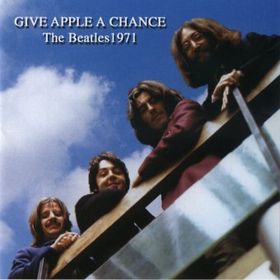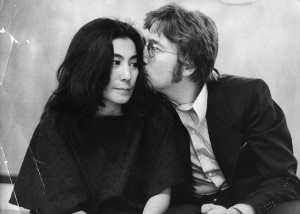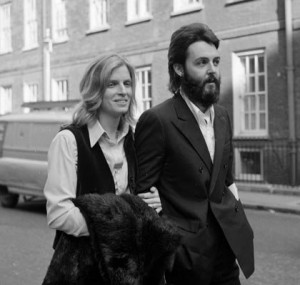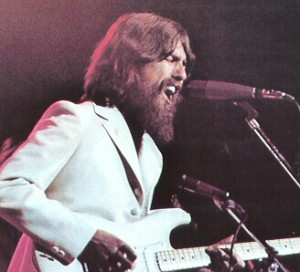Part 2: Imagine (1971)
There’s really no other possible title for this album. But before we go into the follow-up to Join the Human Race, I’m going to go through the ”ground rules” I decided to follow for this series.
Rule #1: What happens after 1980? 
This was the most obvious pressing question I faced: what to do after John Lennon’s tragic murder? I systematically went through the options, and eliminated all but one.
Option 1: Continue after 1980 with only three songwriters/vocalists. Nonsense. Beatles without Lennon = no Beatles at all.
Option 2: Stop the series at 1980. Not only would this cut the number of albums way down, and lessen the space-saving impact of consolidating the solo Beatle albums, it would ignore some great songs recorded after 1980. Plus, with 13 of these albums to make instead of 6 or 7, it’s twice as fun. So no.
Option 3: ”Backfill” the post-1980 albums with more Lennon tunes from the 70s. Tempting, but also no. As much as Paul gets criticized for too much filler on his albums, the Lennon albums had their share of mediocre songs too, and we’d really have to include almost every song from his more limited output. And let’s face it, times change, the Beatles would’ve changed with them, and the more recent albums would sound awfully weird with, say, ”Old Dirt Road” between ”My Brave Face” and ”Devil’s Radio.”
So we’re left with…
Option 4: Julian. Now I will not claim that the two are interchangeable parts, or that Julian Lennon is one-tenth the musical genius his father was, but his best songs are still pretty darned good, his voice could *almost* pass for John’s most of the time, and it’s really the only way to include anything remotely Lennon-related on a post-1980 album that sounds like it was recorded in the same decade that the album was released. So when we get there, either close your eyes and pretend Julian’s songs are actually John’s songs in our alternate universe (and John’s voice softened slightly as he aged, like a fine cheese), or just pretend that John was still murdered in 1980 and Julian replaced him in the group. Or just stop reading this series after we get to 1980. It’s up to you.
Rule #2: Maintain the songwriting / singer balance within each album
The real Beatles albums all included at most one tune sung by Ringo, two written and sung by George, and the remainder split roughly 50/50 between John and Paul (credited to ”Lennon/McCartney” but by 1966, it was usually obvious which one wrote the bulk of a song). I followed this as best as I could, occasionally allowing George a third tune (such as last week), and giving Ringo two on a couple of the more recent albums due to his sudden 21st century prolificity. Paul sometimes got slightly more than John / Julian, also due to the imbalance of material to choose from.
Rule #3: ”Chronological purity”
 This means that all the songs on an album released in a given year have to sound like they could have been recorded in that year. I allowed myself to borrow from the near future or near past in cases where it was necessary (e.g. John’s 1975-80 gap, George’s 1982-87 and 1987-2002 gaps, Ringo’s lack of anything remotely passable in the late 70s), or where the album fit together better by including a song from slightly earlier or later, but no vast mismatches between real year and fake year allowed. I got more liberal with later albums, because (a) There’s not much George or Julian material to choose from and (b) production styles haven’t really changed that much since 1990 (listen to Ringo’s ”Time Takes Time” and ”Y Not” — could you honestly tell which was recorded in 1992 and which was recorded in 2010 if you didn’t know?).
This means that all the songs on an album released in a given year have to sound like they could have been recorded in that year. I allowed myself to borrow from the near future or near past in cases where it was necessary (e.g. John’s 1975-80 gap, George’s 1982-87 and 1987-2002 gaps, Ringo’s lack of anything remotely passable in the late 70s), or where the album fit together better by including a song from slightly earlier or later, but no vast mismatches between real year and fake year allowed. I got more liberal with later albums, because (a) There’s not much George or Julian material to choose from and (b) production styles haven’t really changed that much since 1990 (listen to Ringo’s ”Time Takes Time” and ”Y Not” — could you honestly tell which was recorded in 1992 and which was recorded in 2010 if you didn’t know?).
*GET ON WITH IT!!!* cry the masses…
OK, 1971’s Imagine is here — another album of extremes, in a sense. I originally conceived the songs on this and Join the Human Race as a double album, because they were all recorded fairly close together, and all of George’s songs on either one come from the same album anyway, but decided against it. The White Album is universally praised today, but I don’t think it was back then, and I would guess a steady stream of new material would’ve been a better strategy for the Beatles in the early days of Apple Records. So instead, I thought they would’ve experimented a little with an unorthodox ”whisper to a scream to a whisper” track sequence on Imagine, since the title track really has to lead off the album.
This is one of a few albums throughout this series where I had a particularly challenging time figuring out the best order to put things in. Alternate suggestions therefore are welcome and encouraged! (Of course that goes for even the ones where I like the order as is, but I’ll specifically point out the ones where I had trouble deciding).
Oh, and by the way, just in case you hadn’t figured it out, all the song titles are hyperlinked to YouTube soundclips (and sometimes videos) so you can hear the album. That goes for part One, too.
SIDE ONE (the ”mellow side”)
 ”Imagine” — I can see it: hordes of long-haired teenagers, gathered in the shag-carpeted attic bedroom of the coolest, hippest guy in class (who probably looks like Greg Brady) for a premiere listening party of the groovy new Beatles album, and as the needle hits the vinyl (or the play head hits the 8-track) and those somber piano chords begin… ”whoa, this is different, man! And no religions too, far out! Not sure if I’m gonna dig that Uncle Albert song though…”
”Imagine” — I can see it: hordes of long-haired teenagers, gathered in the shag-carpeted attic bedroom of the coolest, hippest guy in class (who probably looks like Greg Brady) for a premiere listening party of the groovy new Beatles album, and as the needle hits the vinyl (or the play head hits the 8-track) and those somber piano chords begin… ”whoa, this is different, man! And no religions too, far out! Not sure if I’m gonna dig that Uncle Albert song though…”
”Dear Boy” — It’s very tough to follow up ”Imagine” with anything, so I did something similar to what John did on the real Imagine LP, namely just shifted gears with something light and mildly silly, of Paul’s Ram album. I found myself really liking most of Ram upon recent listen, more than I remember. I think it was a bit ahead of its time and people just didn’t know what to make of it in 1971.
”I’d Have You Anytime” — On any other record, this would be track #1, as it was on All Things Must Pass, but here it still serves as an intro to ”the rest of the album.” Attention all men in relationships of any kind: lead your next Valentine’s Day mix off with this one.
 ”Another Day” — Oddly not included on Ram (I think it would fit quite well), this is a sublime early single from Paul. I’ve always thought the bridge, complete with Beatlesque rhythmic shifts (recalling ”We Can Work It Out” a little) and a surprising minor-to-major chord transition (a la ”Things We Said Today”) is really what makes this song tick. Why John chose it to deride in ”How Do You Sleep” I have no idea. You could make a great mix of Paul songs (Beatles and solo) that start straight off with his voice, i.e. without any musical intro.
”Another Day” — Oddly not included on Ram (I think it would fit quite well), this is a sublime early single from Paul. I’ve always thought the bridge, complete with Beatlesque rhythmic shifts (recalling ”We Can Work It Out” a little) and a surprising minor-to-major chord transition (a la ”Things We Said Today”) is really what makes this song tick. Why John chose it to deride in ”How Do You Sleep” I have no idea. You could make a great mix of Paul songs (Beatles and solo) that start straight off with his voice, i.e. without any musical intro.
”Jealous Guy” — I recently read that John originally pitched this to the Beatles with different lyrics (probably of a psychedelic nature), but I’m glad it ended up the way it did. The piano fill just before the chorus has always reminded me of ”A Day in the Life.”
”Monkberry Moon Delight” — And now, for something completely different.
SIDE TWO (the ”angry side” until the end)
”Too Many People” — Right now this is my favorite Paul McCartney post-Beatles song. And it doesn’t really sound too dated (some of the lyrics certainly ring truer than ever) — you might laugh, but I think it’s got a particular indie vibe that isn’t all that different than what you hear in many hip music stores today. The common perception of John as the innovator and Paul as the sellout really isn’t fair and I think most of the people who say that haven’t heard Ram or McCartney II (which we’ll get to in a couple months).
”Gimme Some Truth” — John’s Imagine LP was all over the place, and I keep forgetting this is on it. The Beatles in the 60s were seldom overtly political, focusing mostly on positive messages like ”All You Need Is Love,” but I think even if they’d stayed together they would’ve had a hard time staying positive all the time by this point. Assuming they remained as popular as before, I envision ”Gimme Some Truth” becoming a Watergate-era household protest slogan.
 ”Let It Down” — The loudest and most ambitious of George’s All Things Must Pass soundscapes, I love how it builds and changes mood. In my book the melody in the verses rivals ”It’s All Too Much” and ”If I Needed Someone” as George’s most creative of all time.
”Let It Down” — The loudest and most ambitious of George’s All Things Must Pass soundscapes, I love how it builds and changes mood. In my book the melody in the verses rivals ”It’s All Too Much” and ”If I Needed Someone” as George’s most creative of all time.
”Back Off Boogaloo” — coming right after the most aggressive Paul, John and George songs of the era, Ringo proves he’s down with the tude as well. And he made a video for it too! I love 70s videos, they’re so quaint.
”Uncle Albert / Admiral Halsey” — for me, creating a mythical album is all about the segues. The sudden reversion into pure whimsical Britishness here could be one of the legendary Beatle moments.
”How” — I’m not 100% crazy about ending an album this way, but I looked at what else was here and decided this was really the only song that could come at the end. You could call it a statement that amidst all the preaching and shouting strewn throughout Imagine that the Beatles are really just four blokes from Liverpool and don’t have the answers any more than you or I.
 WELL —KNOWN SONGS FROM THE ERA THAT DIDN’T MAKE IT:
WELL —KNOWN SONGS FROM THE ERA THAT DIDN’T MAKE IT:
”Bangladesh” — too directly about one specific issue, I don’t see the Beatles doing this.
”Woman is the Nigger of the World” — ditto.
”Give Ireland Back to the Irish” — Double ditto. But I recently learned that Paul’s recording of ”Mary Had a Little Lamb” around the same time was not a wuss-out, but in fact a kind of ”sod off, let’s see if you can find a way to ban this!” message to the British media censors who banned ”Give Ireland…” for political reasons and then banned ”Hi Hi Hi” for its pro-drug implications. Further proof that Paul was cooler than we realize.
”How Do You Sleep” — presumably John and Paul would’ve made up at least enough to prevent this from seeing the light of day. But maybe in our alternate reality the lyric sheet was discovered in John’s attic sometime in 1975, precipitating Paul walking off the stage in the middle of a show and a temporary rift that wasn’t healed until… well, I won’t give away when the next album was just yet.
”Crippled Inside” — I always thought it was funny that John made fun of what he called Paul’s ”grandma songs” and then wrote something like this. I’m just not a fan of this one for some reason.
Next time… don’t let me wait too long, but c’moon to 1973 and an album that is hi, hi, higher than the sum of its parts!





Comments